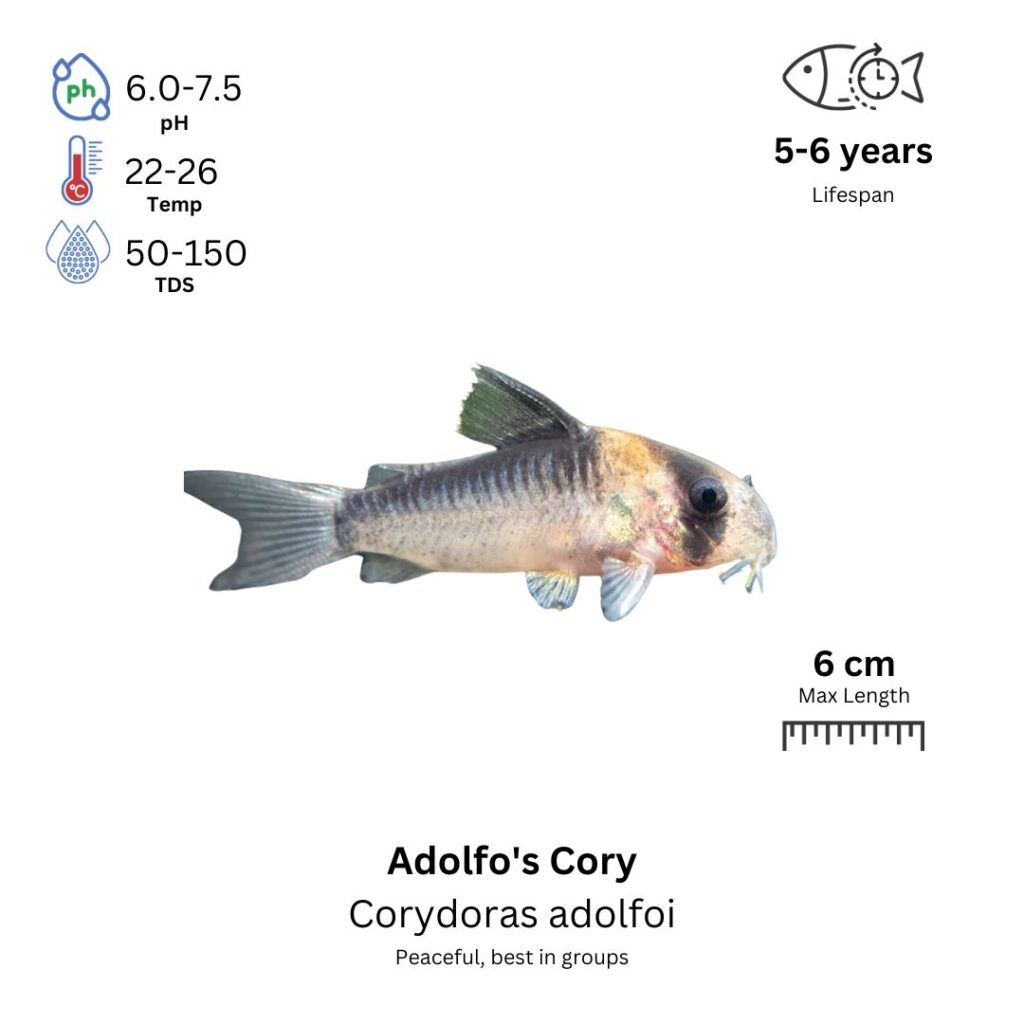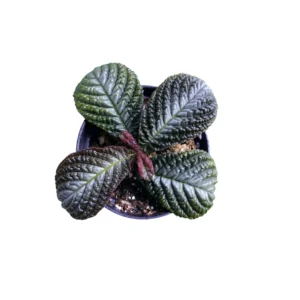Adolfo's Cory
Corydoras adolfoi

Description
Adolfo’s Cory is a beautiful and active species of freshwater catfish, known for its distinctive appearance and peaceful nature. The body of Adolfo’s Cory is elongated and covered in small, smooth scales. The fish’s base coloration is a pale, translucent beige to light yellow, with striking black markings across the body and fins. These markings typically form two prominent black stripes running along the sides of the body, with a dark spot near the tail. The fish also has a distinctive black spot near the dorsal fin and sometimes on the head.
Habitat Origin
Native to the freshwater rivers and streams of the Amazon Basin in South America, specifically from Brazil. These fish are found in slow-moving waters, often near the bottom, where they can forage through the substrate for food. Their natural habitat is characterized by clear water, a soft substrate, and plenty of hiding spots provided by plants, driftwood, and rocks. The water is typically soft, slightly acidic to neutral, and well-oxygenated.
Aquarium
Ideal Number in Aquarium: At least 6 individuals, as they are schooling fish and feel more secure in groups.
Favorite Food

Adolfo’s Corydoras are omnivores and primarily scavengers, feeding on detritus, algae, and small invertebrates found in the substrate. They can be fed a variety of foods, including high-quality sinking pellets, flakes, and live or frozen foods such as brine shrimp, daphnia, bloodworms, and grindal worms. They also enjoy blanched vegetables like zucchini, spinach, and peas. A varied diet will help ensure they stay healthy and vibrant.
Behavior:
Adolfo’s Cory is a peaceful and social species, often seen swimming together in groups while foraging along the substrate. They are calm and non-aggressive, making them an ideal species for community tanks with other small, peaceful fish. These fish are active at the bottom of the tank and will frequently sift through the substrate in search of food. They are also known for their “schooling” behavior, and they are happiest and most active when kept in groups.
Special Care:
Adolfo’s Cory requires stable water conditions to thrive. Regular water changes and good filtration are important to maintain water quality, as they can be sensitive to poor water conditions. A soft, fine substrate such as sand or smooth gravel is ideal, as it allows them to forage comfortably without injuring their delicate barbels. Since they are bottom dwellers, it is important to ensure the tank provides plenty of hiding spots, such as plants, rocks, or driftwood, to help them feel secure. Like other species of Corydoras, they are sensitive to copper-based medications, so it is important to avoid using such treatments in the tank.
Compatibility with Other Fish:
Adolfo’s Cory is a peaceful species and is compatible with many other small, non-aggressive fish. They do well in community tanks with species such as tetras, rasboras, guppies, and other peaceful bottom dwellers. They are also compatible with shrimp and snails. Larger or more aggressive fish should be avoided, as they may stress or harm the Corydoras. These fish are best kept with other small, peaceful species that will not compete for food or invade their territory.
Breeding Tank Setup
A separate breeding tank is strongly recommended when breeding Adolfo’s Cory (Corydoras adolfoi), as it allows for precise control of water conditions and reduces disturbances from other tank inhabitants. A tank size of 40–60 liters (10–15 gallons) is ideal to give breeding pairs space to interact naturally and fry room to develop. Maintain a pH of 6.0–7.5, temperature between 24–28°C, and soft to moderate hardness (4–12 dGH). Use a gentle sponge filter to ensure clean, well-oxygenated water without generating strong currents. Provide fine gravel or sand as substrate, and add flat rocks, breeding caves, or broad-leaved plants for spawning surfaces. Moderate lighting, with some floating plants or shaded areas, helps reduce stress and simulate natural low-light habitats.
Selecting Breeders & Conditioning
To condition Adolfo’s Cory for breeding, offer a nutrient-rich diet consisting of live or frozen foods such as brine shrimp, bloodworms, and daphnia. Supplement this with sinking pellets or specialized Corydoras food to ensure they get enough nutrition. A protein-rich diet is especially important for females to develop eggs and for males to exhibit courtship behavior. Routine partial water changes (20–30%), especially 1–2 days before spawning, help stimulate breeding. A slight increase in temperature to around 28°C can further trigger natural spawning responses.
Spawning Process & Egg Care
Spawning often occurs after a water change or temperature shift. During courtship, the male will approach and display to the female, who will then lay eggs on flat, clean surfaces like rocks, plants, or the aquarium glass. The male fertilizes the eggs immediately afterward. A healthy female can lay between 100–150 eggs in a single spawning event, typically in small clusters. Once spawning is complete, it is critical to remove the adult fish to prevent egg predation—a common issue with Corydoras species.
Fry Care & Feeding
Eggs usually hatch within 3–5 days, depending on the water temperature. After hatching, fry will rely on their yolk sacs for initial nourishment. Once absorbed, feed them with infusoria or liquid fry food. Around the one-week mark, gradually introduce newly hatched brine shrimp or finely crushed Cory-specific pellets. Maintain excellent water quality through small, consistent water changes (10–15% every 2–3 days), and continue using a sponge filter for gentle, safe filtration. Keep the temperature stable between 24–28°C, and avoid strong water movement.
Breeding Maturity, Sexing & Stress Prevention
Adolfo’s Cory typically reach breeding age between 6–12 months, though it’s best to wait until they are fully matured and healthy. Males are smaller and slimmer, often with more vivid coloration, while females are larger and rounder, especially when carrying eggs. To prevent stress, avoid overcrowding, and maintain stable water parameters—drastic changes in pH, hardness, or temperature should be avoided. Ensure the breeding tank is free from aggressive or fast-moving tankmates, as peaceful conditions are essential for successful spawning and fry development.

